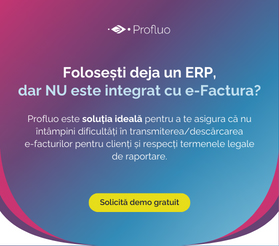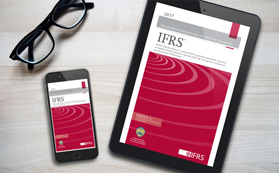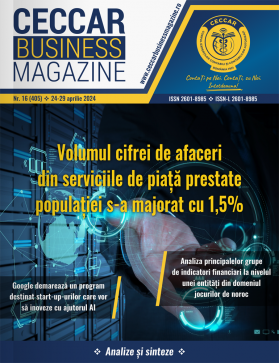
Modification and completion of some accounting regulations
Numărul 39, 4-10 oct. 2023 » Finance & Economics
Order of the Ministry of Finance no. 2649/2023 regarding the modification and completion of some accounting regulations was published in the Official Gazette, Part I, no. 903 of October 6th, 2023.
I. The main changes to the Accounting Regulations approved by OMPF 1802/2014:
➜ In the sense of these regulations, an entity incurs expenses for an asset with a long manufacturing cycle only when those expenses generated cash payments, transfers of other assets or the undertaking of interest-bearing debts.
➜ The category of commitments and other off-balance sheet items includes: commitments (promissory notes, guarantees, sureties) granted or received in relations with third parties; tangible assets taken on rent; material values received for processing or repair, in storage or custody; debtors removed from assets, followed further; stocks of the nature of inventory items put into use; royalties, management locations, rents and other similar debts; expected effects that did not reach maturity; public property assets received under administration, concession or rent by entities; goods from the private domain of the state, which do not meet the conditions for recognition as assets; interest related to financial leasing contracts, not yet due; greenhouse gas emission certificates received, which have not established a value and, therefore, cannot be recognized in balance sheet accounts, as well as other values.
➜ New accounts are entered in the General chart of accounts:
- 1496 "Losses resulting from company reorganizations, corresponding to the negative net asset of the absorbed company" (A);
- 6121 "Expenses with royalties";
- 6122 "Expenses with management locations";
- 6123 "Rent expenses";
- 616 "Expenses related to intellectual property rights";
- 617 "Management expenses";
- 618 "Consultancy expenses".
Account 616 "Expenses related to intellectual property rights"
Account 617 «Management expenses»
Account 618 «Consultancy expenses»
➜ The function of some accounts is changed:
Account 691 "Profit tax expenses"
II. The Accounting Regulations in compliance with the International Financial Reporting Standards, approved by Order of the Minister of Public Finance no. 2.844/2016 are modified accordingly.
III. The Accounting Regulations for legal entities without patrimonial purpose, approved by Order of the Minister of Public Finance no. 3.103/2017 are modified.
With respect to indebtedness costs attributable to assets with a long manufacturing cycle, an asset is normally ready for its intended use when the physical construction of the asset is completed, even though some routine administrative work may still continue. If only minor changes remain to be made, such as the interior decoration of a building according to the specifications of the buyer or user, then it is considered that most of the activities have been completed.
In the sense of these regulations, the date of starting the capitalization of the indebtedness costs, as part of the cost of an asset with a long production cycle, is the date on which the entity meets for the first time all the conditions below:
- bears the expenses for the respective asset;
- bears the costs of indebtedness;
- undertakes the necessary activities to prepare the asset for its intended use.
In the sense of these regulations, an entity incurs expenses for an asset with a long manufacturing cycle only when those expenses generated cash payments, transfers of other assets or the undertaking of interest-bearing debts.
The activities necessary to prepare the asset for its intended use do not only include the physical construction of the asset. They include technical and administrative works prior to the start of physical construction, such as activities associated with obtaining approvals prior to the start of physical construction. However, such activities exclude the ownership of an asset when no activity that changes the state of the asset takes place. For example, the indebtedness costs incurred during the development of the land are capitalized during the period in which the activities related to the development are carried out. On the other hand, the indebtedness costs incurred during the period in which a land acquired for the purpose of buildings is owned without being subjected to associated development activities are not accepted for capitalization.
An entity must interrupt the capitalization of indebtedness costs during extended periods in which it is not actually working on the realization of the asset with a long manufacturing cycle.
Note: The provisions of points I-III apply starting with the annual financial statements related to the financial exercise of the year 2023.
By way of exception, the provisions of point III regarding the interruption of the capitalization of indebtedness costs, apply starting with the annual financial statements related to the financial exercise of the year 2023, if the effect of the change in the accounting policy can be established until the date when the respective annual financial statements are approved. Otherwise, the respective provisions apply to the indebtedness costs borne by the entity in connection with loans contracted after January 1st, 2024.
Entities that have chosen a financial exercise different from the calendar year apply the provisions of art. I-III starting with the first annual financial statements concluded on a later date than January 1st, 2024.
(Copyright foto: 123RF Stock Photo)
















Actuala „ofensivă” a cărţii înregistrează noi victorii pe „frontul” lecturilor de calitate
Susţinere financiară suplimentară pentru protejarea „Tezaurului Uman Viu”
ArtSafari: cinci expoziţii de excepţie cu opere ale marilor artişti plastici români
Istoria Teatrului, o „scenă” pentru eternitate
Cartea pentru copii, de la „Cenuşăreasă” la podiumul premianţilor
Monumentele istorice, comori pentru eternitate
La MNAR, filmul de artă este la el acasă
România devine un hub cultural-artistic atestat şi de un important festival cinematografic